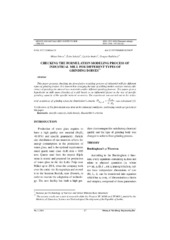| dc.creator | Petrov, Milan | |
| dc.creator | Sekulić, Živko | |
| dc.creator | Andrić, Ljubiša | |
| dc.creator | Radulović, Dragan | |
| dc.date.accessioned | 2023-04-21T11:26:25Z | |
| dc.date.available | 2023-04-21T11:26:25Z | |
| dc.date.issued | 2016 | |
| dc.identifier.issn | 2334-8836 | |
| dc.identifier.uri | https://ritnms.itnms.ac.rs/handle/123456789/377 | |
| dc.description.abstract | This paper presents checking the formulation modeling process of industrial mill for different types of grinding bodies. It is known that changing the type of drilling bodies realizes various efficiency of grinding the mineral raw materials and/or different grinding fineness. This paper gives a hypothesis on bulk mass (density) of a mill batch as an influential factor to the size of specific grinding capacity of the specific mineral resources. The experiment was carried out in the industrial conditions of grinding when the Damkohler's criteria = was calculated [1]. Verification of this formulation was done in the industrial conditions, and testing results are present in this paper. | en |
| dc.publisher | Institut za rudarstvo i metalurgiju, Bor | |
| dc.relation | info:eu-repo/grantAgreement/MESTD/Technological Development (TD or TR)/34006/RS// | |
| dc.relation | info:eu-repo/grantAgreement/MESTD/Technological Development (TD or TR)/34013/RS// | |
| dc.rights | openAccess | |
| dc.source | Mining and Metallurgy Engineering Bor | |
| dc.subject | specific capacity | en |
| dc.subject | Damkohler's criteria | en |
| dc.subject | bulk density | en |
| dc.title | Checking the formulation modeling process of industrial mill for different types of grinding bodies | en |
| dc.type | article | |
| dc.rights.license | ARR | |
| dc.citation.epage | 54 | |
| dc.citation.issue | 2 | |
| dc.citation.other | (2): 47-54 | |
| dc.citation.rank | M24 | |
| dc.citation.spage | 47 | |
| dc.identifier.doi | 10.5937/MMEB1602047P | |
| dc.identifier.fulltext | https://ritnms.itnms.ac.rs/bitstream/id/153/374.pdf | |
| dc.identifier.rcub | conv_424 | |
| dc.type.version | publishedVersion | |

